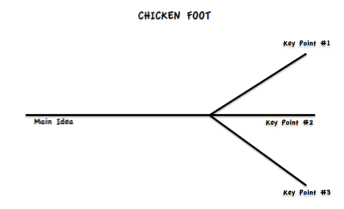This is a follow-up from an earlier post and video lecture explaining how to use MEAL paragraphs as routine writing tasks that help students build stronger body paragraphs. Many classes start with a “Warm Up” that is used to hook students into the lesson, or in this case textbook. In order to use MEAL paragraphs in this fashion, the instructor merely needs to pose an arguable question that requires students to take a position, then find three pieces of textual evidence and explain how the evidence supports their main idea. Finally, they link their evidence and analysis back to the main idea of the paragraph. For these examples, my questions were: (1) Was Operation Overlord a triumph of planning or a lucky break? and (2) Should island hopping be considered a success or failure?
This student does an adequate job with the MEAL format, below you can see their main idea highlighted in yellow. It is indeed a thesis that takes a position on the question and provides three reasons. I am eager to read on. Unfortunately, when highlighting the evidence in turquoise, I realize this writer only provides two pieces of evidence for their thesis. I hunt for textual evidence that the allies have succeeded in completing the first part of their plan, but I can’t find any. Therefore, I stop reading. This is not the perfect MEAL paragraph.
So unfortunate. This student had a strong thesis, solid analysis, and even restated their thesis at the end of their paragraph. They just needed to include one more piece of evidence to get the points on this quickwrite.
The next student sample on island-hopping is similarly well-organized. The main idea is highlighted in yellow. The evidence is highlighted in turquoise. The analysis is in green and the thesis is restated at the end of the paragraph in purple. Aside from a slight redundancy in swimming to shore and fighting the Japanese in trenches (not factual), this author has created a solid MEAL paragraph.
This sample can be used as a mentor text when showing students how to write MEAL paragraphs. I have found some students will copy your model word for word, so it helps to have a supply of examples that aren’t on the topic you are asking your students to write about.
MEAL paragraphs should be an arrow in every effective educator’s quiver. Students who repeatedly write MEAL paragraphs gain extensive practice in identifying and explaining textual evidence. You will see an immediate improvement in their writing. Please feel free to leave any comments about integrating MEAL paragraphs into your everyday classroom practices.






